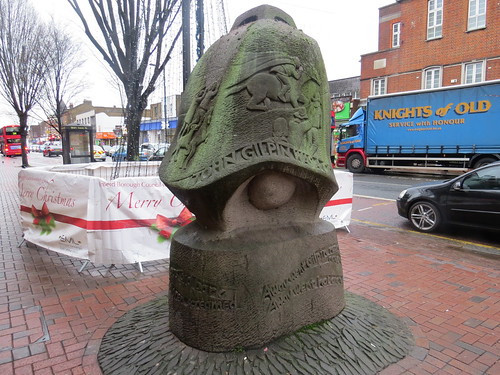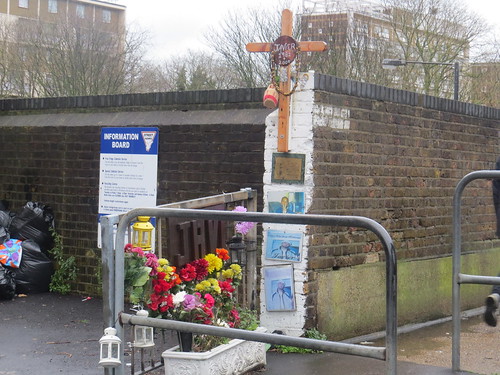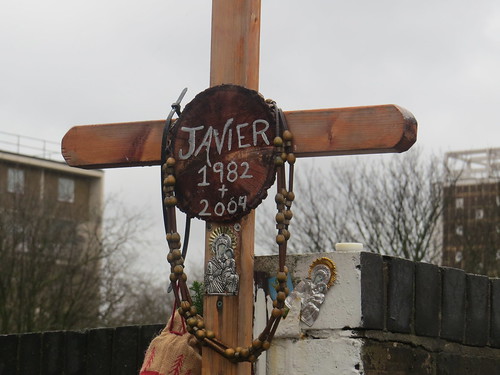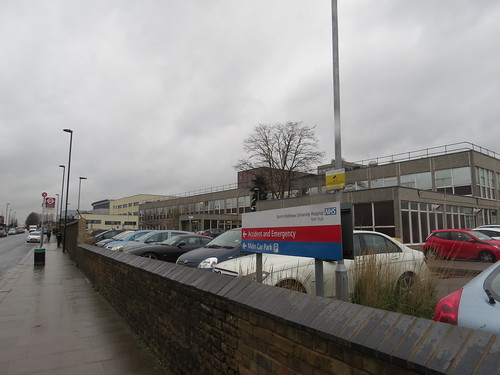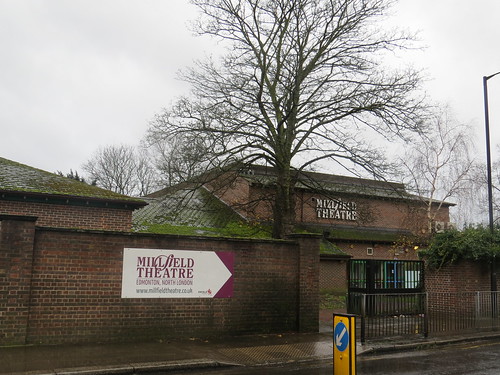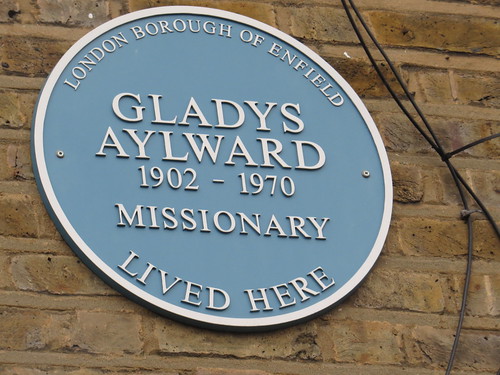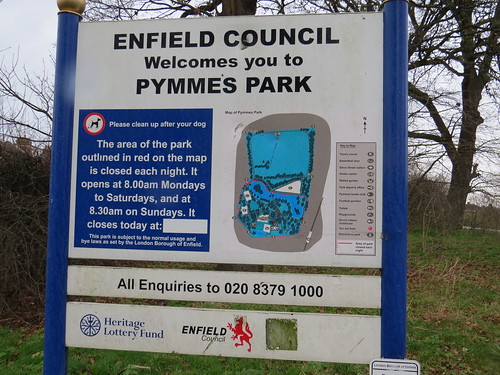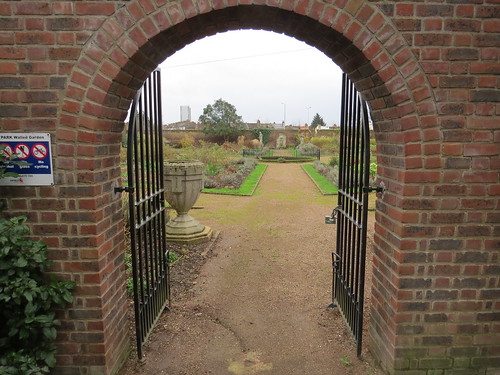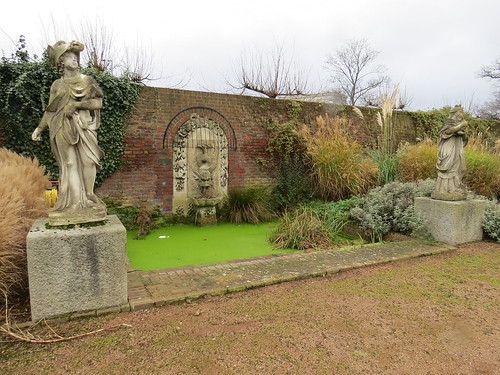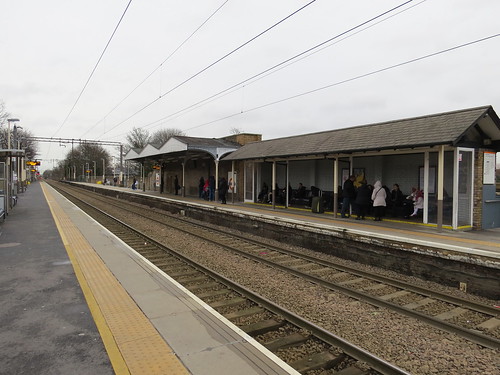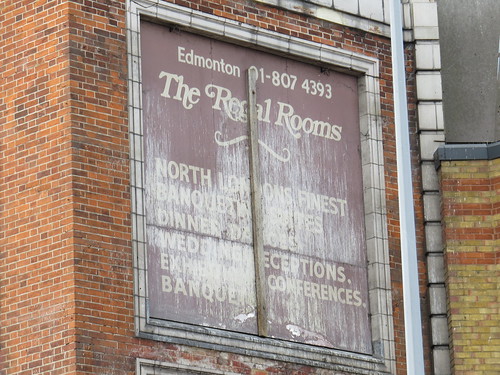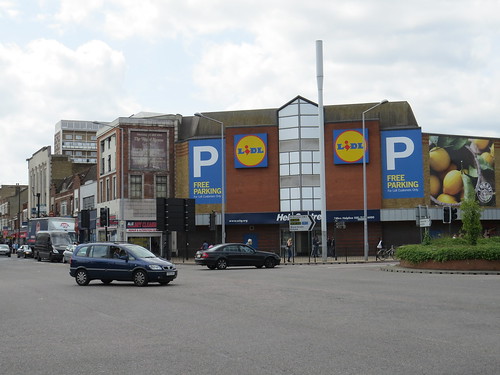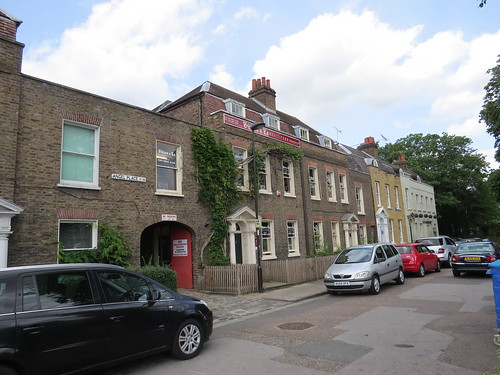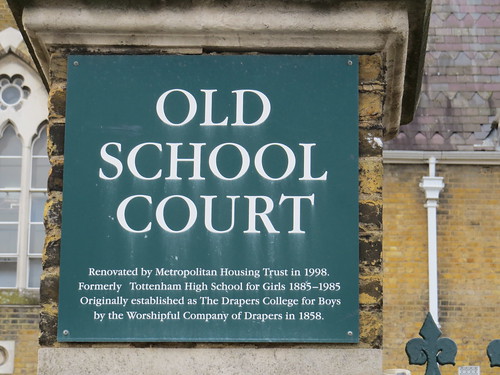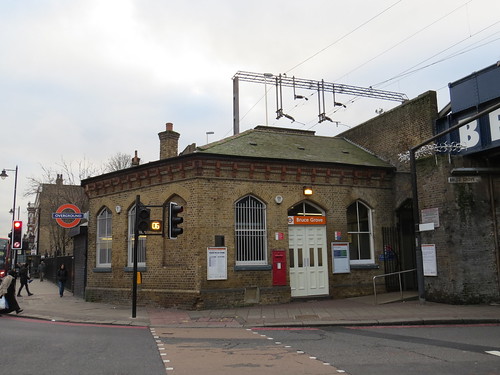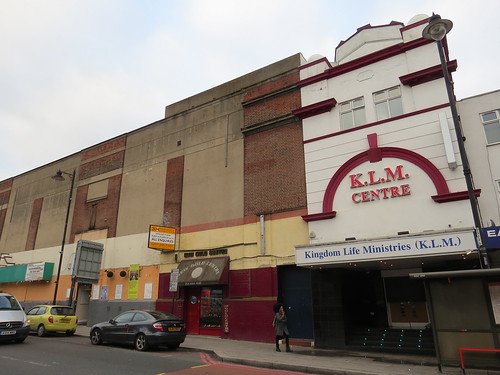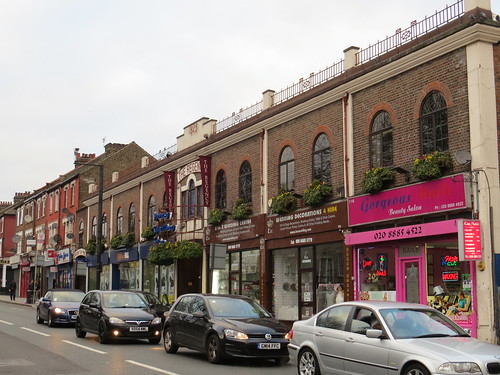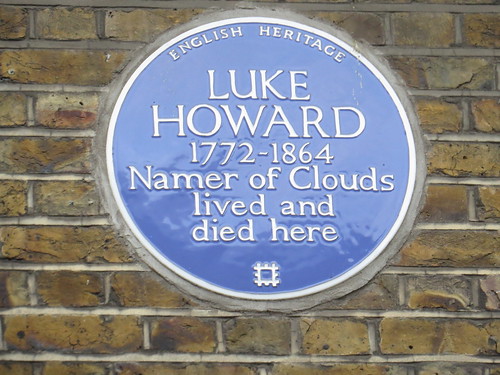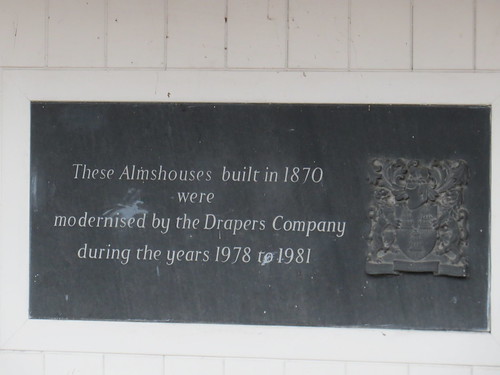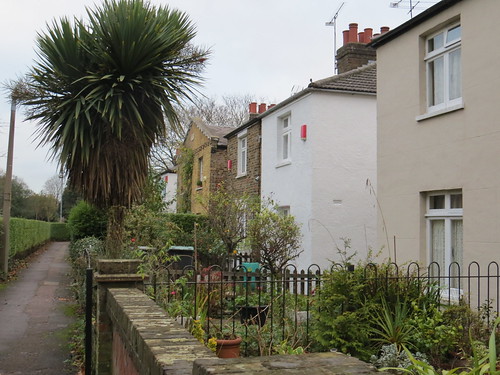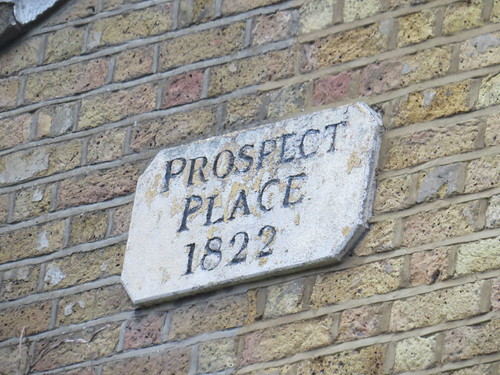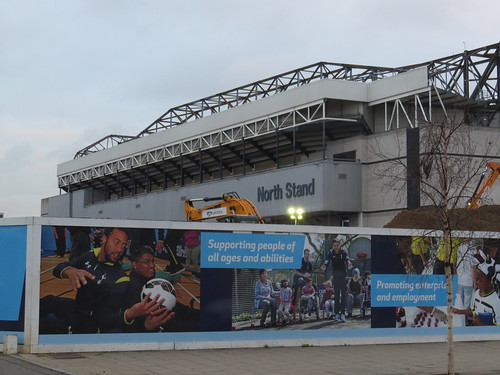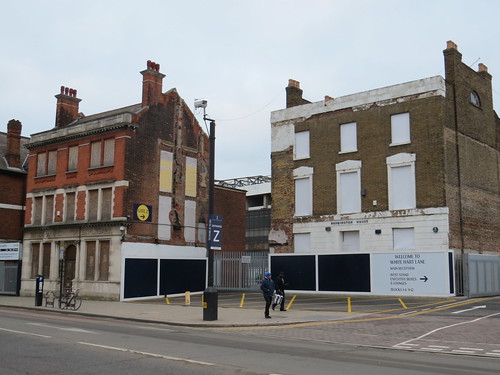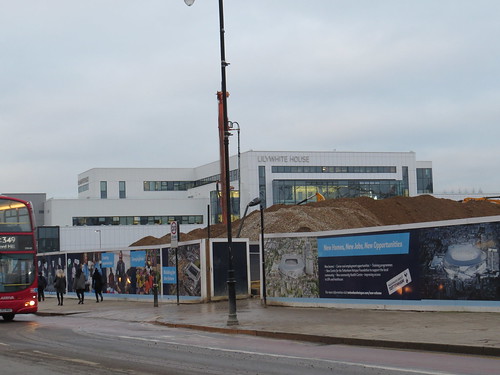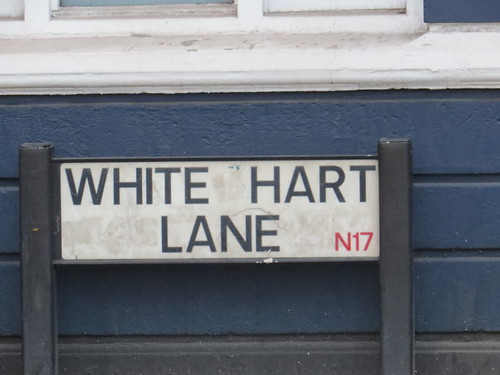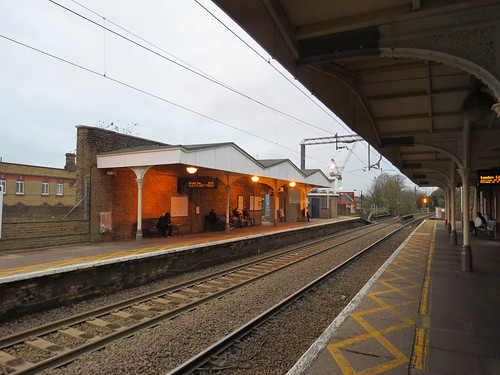N18 is Upper Edmonton which is squeezed between N9 Lower Edmonton and N17 Tottenham.
We start our walk at Upper Edmonton Post Office which is at 83 Fore Street, N18.
Turn left out of the Post Office and our first stop is a little way along just outside Fore Street Library which is at 109 -111 Fore Street.
Stop 1: The Gilpin Bell sculpture
Well here is an odd thing to find along this nondescript shopping street.
This is called Gilpin’s Bell and is by Angela Godfrey and dates from 1996. It was inspired by a comic ballad from 1782 by William Cowper, entitled “The Diverting History of John Gilpin”.
This is the story of Gilpin and his wife and children on a journey to the Bell Inn, Edmonton. They become separated after Gilpin loses control of his horse, and is carried ten miles farther to the town of Ware. And much the same thing happens on his return when he is carried past Edmonton back to the City.
As an entertainment, this does seem rather tame by today’s standards. And the sculpture itself is not that well located and it seems to be getting a bit weathered but maybe that was the intention.
Retrace your steps along Fore Street.
If you want to keep going and you can see the Wetherspoons pub, Gilpin’s Bell which also celebrates the story and is close to the site of the old Bell pub which was demolished in 1963.
By the way this pub is on the border with Tottenham, not so far from White Hart Lane football ground and it seems that on match days entry to this pub is restricted to home supporters. So beware if you are here on a match day and are not a home supporter, because you will not get in. But then again why would you volunteer to go anywhere near a major football ground on a match day unless you were actually going there.
If you do not want to take this short detour, turn right into the side street between the White Horse pub and Corals bookmakers. Otherwise return back to this point on Fore Street and turn left.
Go ahead into Joyce Avenue, going through the housing estate and you will see a slope leading up to a bridge over the railway.
Go over that bridge. Our next stop is just on the other side.
Stop 2: Javier’s memorial
I have no idea who Javier was or why he is memorialised here. My Google searches have thrown up nothing. One can only assume he died on the railway just here. The memorial has been here some years and perhaps predates the time when people obsessively published material on the Facebook and elsewhere on the internet.
It is also an unusual survivor. Normally these roadside shrines are removed by the council after some months. But this one has survived presumably because it is in a no man’s land between the council’s highway land and railway land.
Go straight ahead along Bridport Road. Our next stop soon sprawls out all along the right hand side of the road.
Stop 3: North Middlesex hospital
This site was originally Edmonton workhouse in 1842. A separate hospital building was opened in 1910. It became a military hospital in 1915, known as Edmonton Military Hospital. Once back in civilian hands in 1920, the hospital became known as the North Middlesex Hospital – or the North Mid. It is the main hospital for this part of North London.
Walk along Bridport Road and turn right into Bull Lane. As you approach the North Circular Road you will see a subway on your left. Use this to cross the main road. Once on the other side, keep going. This is Tanner’s End Lane. At the end of this street turn left and our next stop is a short distance on the left.
Stop 4: Millfield House and Arts Centre
Go through the gate and ahead to the left is the old house, dating from 1796.
Although owned by John Wigston of nearby Trent Park, it was initially let to the Imperial Ambassador of the German Empire. Later (in 1849) it became a school for children of the Strand Union Workhouse children. The Strand Union Workhouse was based in the City of Westminster, but ended up setting up an outpost here next door to the Edmonton Workhouse.
There is a fascinating website called http://www.workhouses.org.uk which gives a lot of information about the Strand Union and Edmonton Workhouses http://www.workhouses.org.uk/Strand/ and http://www.workhouses.org.uk/Edmonton/
It became a hospital in 1915 and was converted to become an Arts Centre in the 1970s, based in the house.
A purpose built theatre and library was opened on the site in 1988. The library relocated to Fore Street in December 2008 and the building was redeveloped as a cafe bar and performance space.
The theatre was reopened in October 2009 by local boy Sir Bruce Forsyth after whom the main auditorium was renamed.
If you have ventured into the site go back to Silver Street and just along from the car entrance you will see a street (Windmill Road) across the road with a school at the corner. This is the Aylward Academy, named after Gladys Aylward, more of whom anon..
Go down Windmill Road and take the third turning on the right. Our next stop is a little way along on the right.
Stop 5: Number 67 Cheddington Road
Number 67 was the home of Gladys Aylward (1902 – 1970) who was a Christian missionary to China.
Her story was told in the book The Small Woman, by Alan Burgess, published in 1957, and made into the film The Inn of the Sixth Happiness, starring Ingrid Bergman, in 1958. The movie was produced by Twentieth Century Fox, and filmed entirely in North Wales and England (!) with most of the chinese children in the film coming from Liverpool where there was a sizable chinese population.
Apparently Aylward was not happy with her depiction in the film. Whilst she was small in stature with dark hair and a London accent, she was played in the movie by the tall Swedish actress Ingrid Bergman. And the story was romanticised. And one of the chinese characters (the mandarin of the town in which Aylward lived) was played by Robert Donat, who was most definitely not chinese. This was his last movie – he died before the film was released. We saw his blue plaque in NW11.
Intriguingly, the establishment of the film’s title was actually called the Inn of the Eight Happinesses – eight being an auspicious number in China and there being eight desirable attributes: Love, Virtue, Gentleness, Tolerance, Loyalty, Truth, Beauty, and Devotion. But for some reason the film version called it the Inn of the Sixth Happiness.
Continue walking along Cheddington Road. At the end do a right then an immediate left into Park Lane. Take the fourth turning on the right (Sweet Briar Walk). This goes alongside Pymmes Park. As the road takes a turn to the right there is an entrance to the park go in here. Follow the path with the lake to your left.
Stop 6: Pymmes Park
Pymmes Park originated as a private estate. In the late 16th century it was owned by the powerful Cecil family. In 1589 Robert Cecil, later 1st Earl of Salisbury, spent his honeymoon at Pymmes. The estate was eventually acquired by Edmonton Council and opened as a public park in 1906. Pymmes House was destroyed by fire in the 1940s and the remains were demolished.
There is a rather nice walled garden, though it is sadly marred by the noise of the nearby North Circular Road. You find this by searching out the Visitors Centre which is rather strange looking white building that looks like it has escaped from an army camp.
If you go to the right of this, you will find an archway that leads into the walled garden.
Head back round the Visitors Centre and go out on to Silver Street.
Ahead you should see the railway on an embankment and some steps going up to Silver Street station, our next stop.
Stop 7: Silver Street Station
This is the next station after White Hart Lane going out of London. Built in 1872 and like the other stations we saw in N15, N16 and N17, it has those unattractive unroofed stairs. It should perhaps have been called Upper Edmonton, but was not.
The London bound platform retains its canopy, although altered and strangely extended. The country bound platform has lost any covering it might have had.
Back down to street level, go under the railway and continue to the junction. Although you cannot see it you are standing on top of the North Circular Road which at this point has been tunnelled. Our next stop is at the corner of Fore Street.
Stop 8: Site of Regal Cinema
There is a ghost of a sign to hint at what was once here.
This was the location of a huge cinema called the Regal. Opened in March 1934, it seated almost 3,000 people and had full stage facilities. It also contained a restaurant and ballroom, which each had their own separate entrances.
According to the wonderful Cinema Treasures site, the building was owned by the Abrahams family, but it was initially operated by the Hyams & Gale circuit. They were taken over by Gaumont in October 1935. Eventually Gaumont became part of the Rank Organisation but always the building was owned by the Abrahams family who installed clauses in the lease that it should always remain fully equipped as a cinema with full working stage facilities.
The stage was used less frequently as years went by, but still packed them in when artists such as The Beatles and Frank Sinatra appeared.
The cinema closed in July 1972 but it was reconfigured with the stalls seating removed and the floor levelled, becoming a disco and live concert venue named the Sundown. Groups such as Hawkwind, Doctor John, Steppenwolf and The Groundhogs played this venue.
However, this venture lasted less than two years and in March 1974 it reopened as the Regal Cinema, using seating that had remained in the circle. This was also not successful lasting only until August 1974.
The Regal Cinema became a Top Rank Bingo Club. Bingo lasted until 1985 when planning permission was granted for demolition which happened during November/December 1985.
Right up to the end, the Rank Organisation had honoured the lease and kept all equipment in the theatre to full working order. Cinema Treasures says that projectors were well oiled and run on a weekly basis just in case films returned, the stage revolve, curtains and screen were all there, even the organ which was often still used at well attended concerts and to entertain the bingo players was in immaculate condition when the bulldozers moved in.
A Safeway supermarket was built on the site which is today a Lidl supermarket.
Now with your back to the supermarket go up Fore Street, crossing the side street. Our next stop is ahead on the right.
Stop 9: Angel Place
This is a interesting survival – a terrace originally dating from around 1730 which were altered in the middle of the 19th century. Now Grade II* listed buildings.
185, 187 and 189 were extensively restored in the 1980s to include the formation of an arch at 187 Angel Place with gardens behind.
Set back from Fore Street, the buildings were adjacent to The Angel public house. But today there is no Angel. The Angel was demolished to widen the North Circular Road, but which cannot now be seen as previously mentioned this road is below us in a tunnel..
Continue along Fore Street
Stop 10: site of Alcazar cinema
Just a little way along is a 1960s block of shops and flats and guess what, this was the site of an old cinema.
The Alcazar Cinematograph Theatre opened in June 1913 as part of an entertainment complex which included an enclosed Winter Gardens, which had a palm court and provision for dancing, and an outdoor Summer Gardens as well as a roller skating rink and a tea room. The building was designed like a Moorish palace, with a covered veranda stretching 140 feet along the facade at first floor level.
According to Cinema Treasures, demand for seats at the opening was so great, that the 1,700 seat cinema was filled to capacity and seating had to be placed in the Winter Gardens to take the overflow. It became a regular occurrence to screen popular films in both spaces, and in summer months, the Summer Gardens were also used as a cinema.
The Alcazar was rebuilt in 1933 and was the last cinema in the area to be fitted with sound equipment. It suffered badly when the new giant Regal Cinema opened in March 1934 just up the road on Angel Corner.
The Alcazar closed when it was hit by German bombs on 23 August 1940. This destroyed the dance hall and one wall of the cinema, causing the roof of the auditorium to cave in. Further damage was done by a V1 flying rocket which landed nearby in October 1944.
The remains were demolished and the site stood derelict until the 1960s, when the council built a small parade of shops with flats above, and houses at the rear on the site of the Summer Garden.Today a British Red Cross Charity Shop is located where the entrance to the Alcazar Picture Theatre once was.
Strange to think that for a brief period of around 30 years there was this exotic building here in Upper Edmonton. And one wonders if it had not been destroyed by enemy action as to whether it might have survived til today.
Well that brings us to the end of our N18 walk. We have seen a rather odd sculpture (and pub) reminding us of an obscure 18th century song, we have heard about a missionary and how her life story was treated by the movie industry. and we have seen the sites of two old cinemas, where today there are just ordinary workaday buildings. I thought N18 had little promise when I started but like many of these outer areas there are still some interesting nuggets to reveal.
https://www.eventbrite.co.uk/e/merton-park-the-little-known-garden-suburb-tickets-12396639683?ref=ebapihttps://www.eventbrite.co.uk/e/merton-park-the-little-known-garden-suburb-tickets-12396639683?ref=ebapiFor onward travel you could return to Silver Street station or there are plenty of buses along Fore Street.

